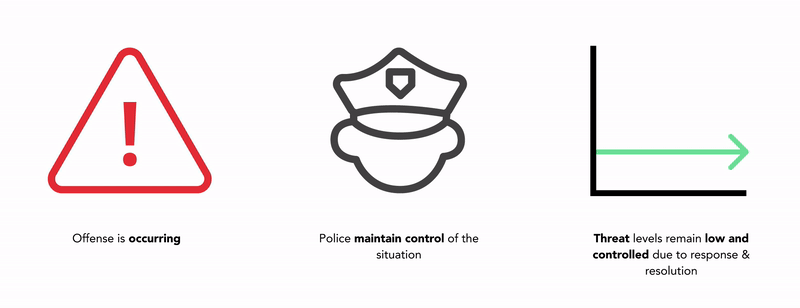
RECON: Centralized System Integrated with Policing Technology Platforms
This project examines the present and future of policing in the UK, aiming to create a revised vision for adapting their work to incorporate technological, social, and economic changes.
Role in Group
Research & Strategy
Information Architecture
Video Production
UX/UI Design
Service Design
The Challenge
Austerity, Understaffing, Mental Health, & Reduced Public Trust
Austerity in the UK has caused budget cuts & lack of funding in policing. Knock-on effects from these have resulted in understaffing, leading to officer departures and increased stress on remaining frontline officers. This strain has resulted in inadequate responses to emergency calls and diminished public trust.
Align with the 'Policing Vision 2025' introduced by the National Police Chiefs Council(NFCC), aiming to implement positive changes in the UK's policing system with future trends. We aim to revolutionize the criminal justice system by leveraging technological intervention to bring out positive changes.
The Insights
Through the interviews with R&R Police officers, they are facing a multitude of daily stresses being on the frontline and many of which reduce the efficiency of their work.
R&Rs must react to both ongoing and past crimes. If there is a way to filter out transpired offenses, allowing R&Rs to focus solely on active crimes, it minimizes unnecessary job responses and enhances availability for greater emergency jobs.
The police are adapting to the introduction of new technologies to leverage existing protocols. Digital policing will make it easier for the public to make contact with the police wherever they are, enable us to make better use of digital intelligence and evidence, and transfer all material in a digital format to the criminal justice system.
Undergoing a new era of austerity, the funding for the police may not be dramatically improved; however, we wanted to leverage the existing technology and systems used with a new assistive platform to make the system stronger, rather than introducing something completely brand new.
The Outcome
Co-created with 2 R&R Merseyside Police officers, RECON is designed to be a filtration system within the current network, separating how occurring and transpired crimes are reported and responded to, and in turn create a new response protocol.
RECON envisages that within the next 5 years, the new protocol will significantly reduce pressure on these officers and greatly improve the public trust.
Insights from Initial Desk Research

Austerity
The main problems highlighted from our initial research were austerity, how economic trends have led to police budget cuts, and lack of funding.

UNDERSTAFFING
“Austerity has brought huge budget cuts. We are understaffed! Officers are leaving the force within 2-3 years of joining!”
- Samuel Nelson, Inspector in Metropolitan Police

INCREASED PRESSURE
100% of officers we contacted said that themselves or a colleague have suffered with mental health as a result of being in the force.

REDUCED PUBLIC TRUST
There are simply not enough officers on the streets to tend to 999 calls. As a result of this inefficiency, this leads to reduced public trust in the police.
Benefits of Digital Formatting
-
Citizen-police relationship
-
Direct contact with police
-
Digital tools
-
Transfer material in a digital format
-
Improve workforce retention
These main problems have also been recognised by the National Police Chiefs Council (NPCC). In 2015 they launched “Policing Vision 2025” which set out a 10 year plan to introduce a series of positive changes to our policing system in line with future trends. The council envisioned a streamline criminal justice system through new digital formatting to bring about positive changes.



Future Focus:
"Digital"
& How do we approach?
Interview with 2 R&R Police Officers
Response & Resolution officers (R&Rs) are facing increased pressures from understaffing and face a multitude of daily stresses being on the frontline. Many of which reduce the efficiency of their work.
Pressure: Calls
Understaffing causes difficulty with the number of calls that can be tended to at a time. R&Rs will be on their way to a “priority” job which has to be attended to within 1 hour, however, during their commute they can be diverted to an “emergency” labeled job, for which they have 15 minutes to get to. In many cases, the R&Rs are collectively unable to attend the number of calls they are expected to go to due to understaffing, which in turn impacts police personal targets and negatively impacts citizen trust in the police.


*showcasing the way of dealing with calls

“Priority” labeled job - 1 hour
Higher priority calls coming whilst on route to job
“Emergency” labelled job
- 15 minutes
R&R officer is diverted.
Original job not seen to as promptly.
Citizen becomes frustrated
Pressure: Jobs
R&Rs are always the main priority when responding to ongoing or transpired offenses to maintain order within communities. However, some situations are considered time wasteful, such as low threats low-value jobs where a complaint isn’t being logged, certain past offenses, or when other departments have more specific skill sets for the situation. They must follow strict protocols for any offense, big or small, and complete every assigned job before moving on to another, even when they are radioed for other jobs that could be of greater importance. Due to being on call throughout the entirety of their shifts, R&Rs feel increased stress and burnout from the hours they work without proper breaks, affecting their morale.


*showcasing the way of dealing with jobs

Low threat low value, over exaggerated report.
Neighbourhood watch is better suited
Past offense is better suited for investigations
R&Rs suffer burnout from having insufficient breaks.
Existing System Map
R&Rs are the first point of call because current protocol expects them to respond to 999 calls. Then the job is filtered to the relevant department who deal with it if further action is needed. This is the current response system:


Existing System
Digital Intervention?
As the complaint process to reach investigations is quite long, we questioned whether some of the human elements of responding to crimes could be replaced with future technology. However, it’s not possible to accurately predict the threat level of a crime; imagine not sending an officer to a situation that then quickly escalates - the consequences would fall on the R&Rs that could’ve been there, and public trust in the police would worsen. By law, R&Rs must be there to anticipate higher threats.
Types of Crimes


Opportunities
It is the responsibility of the R&Rs to respond to ongoing as well as transpired crimes. We believe that if there was a way to filter out transpired offenses, so that R&Rs are only responding to occurring crimes, it would make their jobs easier.

Ideation
Police officers have reported that they are adapting to the introduction of new technologies to leverage existing protocols. Therefore, we wanted to leverage the existing technology and systems used with a new assistive platform to make the system stronger, rather than introducing something completely brand new.
Current Platform:
Webstorm - Call log system
Pronto app - Police pocket computer that connects to Webstorm and Niche
Niche - Crime report system






RECON 2026
New Response Protocol
Centralised System Integrated with Policing Technology Platforms
To alleviate the pressure inflicted by the inefficiencies of the police response system on R&R officers by leveraging technological interventions.
RECON 2026
Co-created with two R&R Merseyside Police officers which is a filtration system within the current network, separating how occurring and transpired crimes are reported and responded to, and in turn create a new response protocol
Webstorm - Call log system
Pronto app - Police pocket computer that connects to Webstorm and Niche
Niche - Crime report system

Response Protocol
In our new system, we have introduced additional formats that directly connect our 3 main stakeholders (control room, frontline officers, public) in order to create a smoother response system.

An initial filtration system when 999 is dialled
A digital platform that provides the public with a service to digitally upload crime reports and complaints from transpired crimes straight to Niche
Incorporating the use of some assistive technology within the control room to respond
better to occurring jobs
Storyboard - Prototyping
The video presents several scenarios to demonstrate how RECON works
Voice by teammate: Sayali Deshpande
Video Editing: Cynthia Pan
How Does it Compare to the Current System?
By adding a stage for when people call the police, asking if the offense is occurring, requires a special procedure, or has transpired, this educates the public on when to call 999. If it is transpired, the citizen is directed straight to RECON or online platform. If it’s occurring, the normal response protocol continues.

New System
Its different from how we report an offense today by changing the way reports are logged. It creates a new capability of complaint/no complaint being reported digitally by the public and directly being sent to Niche; then when needed, passed straight onto investigations, without the need for R&R deployment.

IMPACT & VALUE
Digital Platform
-
Prioritized Dispatch
-
Reduced Pressure
-
Improved Morale
-
Reduced Response Time
-
Improved Relationship
-
Improved Connectivity

IMPACT & VALUE
Digital Control Room Assistive Technology
-
Predictive Policing from Heat Mapping
-
Collaborative Policing
-
Increased Efficiency of Response
-
Increased Transparency
-
Improve Public Safety and Knowledge
-
Improving Public Trust
Summary

To conclude, the main issues with policing currently are austerity, understaffing and the pressure and stress faced by R&R officers. Our new protocol works by streamlining the current system map to make the roles of R&R officers more efficient.
We envisage that within the next 5 years, the new protocol will significantly reduce pressure on these officers and greatly improve the trust between police and the general public.

Process

Wireframes

Prototype

Information Architecture


